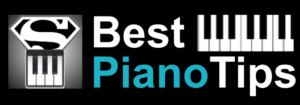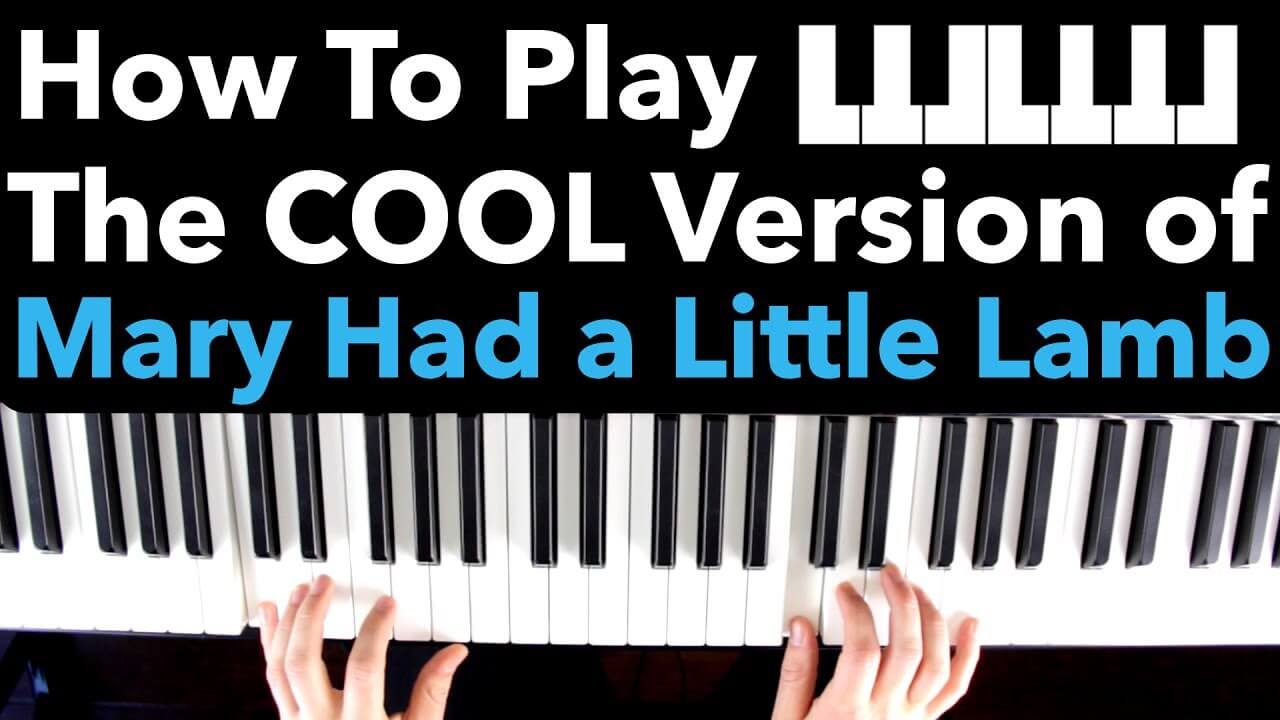This is not your grandma’s version of “Mary Had a Little Lamb!” Today I’m going to teach you how to play a COOL version of the song. If you’re a beginner and it LOOKS challenging, just know that it’s actually much easier than it seems.
I’ll show you EXACTLY how to practice this updated version of “Mary Had a Little Lamb” but it only works if you follow along step-by-step. This video will let you actually see what I’m doing and it starts with a demonstration of how it’ll sound in the end. Check it out for more detailed instruction.
You’re going to learn the exact notes to play and also about harmonizing a melody as well as a couple techniques that can be used to spice up melodies. You won’t just be memorizing a random series of notes – you’ll actually be learning something you can apply to other songs in the future.
Harmonizing a Melody With Chords
When I say “Harmonizing a Melody” what I mean is finding left hand notes and chords that sound good and go well with a melody line.
“Mary Had a Little Lamb” is actually a GREAT starting point to master this skill since it has such a simple melody to begin with.
We’ll start off by learning the actual melody for “Mary Had a Little Lamb.” Take a look at the video for a quick demonstration of this.
Next, we’re going to figure out which chords to use. There are a bunch of different chords, but what you’ll realize once you learn a little music theory, is that you can notch down the possible set of chords to a really small percentage and it makes it much easier to harmonize.
First, we start in the “Key of C” which contains all of the white notes. A “Key” simply means a set of notes. So, when we’re playing a song in the “Key of C,” MOST of the notes will be white notes.
Now we’re left with seven possible chords. Yes, there are other possible chords in the “Key of C,” but they’re MUCH more rare. If you’re a beginner you’re actually only going to be focusing on six chords first – C, Dm, Em, F, G, Am.
If you sign up for my free Become a Piano Superhuman course, you’ll get the cheat sheets for all this stuff. No matter what key you’re in, no matter what chord you’re playing, you can quickly and easily find it.
Getting Started
To start harmonizing a melody, take the “Key Notes” in the melody and find chords that contain those “Key Notes.” Then, use your ear to decide if you like it.
In our “Mary Had a Little Lamb” example, we’ll take just the first four notes. The “Key Notes” are typically played on the strong beats of the measure. Notes 1 and 3 are the strongest beats, 2 and 4 are the next strongest beasts, and the “Ands” between the notes are the weakest parts.
For this song, that means the strongest notes are the E and C. The D is kind of just in between the strong notes.
When we harmonize we have an E and C so we want to look for a chord that has an E and C in it. If you use your cheat sheet or just know your chords really well, you’ll find that really the only chords that have an E and C is our C major chord and our A minor chord. If you play a D minor chord it doesn’t have an E or a C in it so it’s going to sound weird if you play it. If you play an E minor chord it sounds a little better because it has that E in it, but it doesn’t have that C so it’s going to sound kind of weird.
Choosing the “Right” Chords for “Mary Had a Little Lamb”
So, how do we choose? We just try them. Let’s say we try a C major chord – you’ll find it sounds good. How about an A minor chord? That actually sounds kind of cool. The real chord for “Mary Had a Little Lamb” is actually C major, but I think the A minor chord sounds cooler. It kind of gives a dark feeling to it.
Many times I won’t use the “real” chords in a song if I find other chords that sound cooler. It’s a little trick that audiences LOVE too because it sounds unique. This is also the benefit of harmonizing your songs.
Next step, we have our A minor chord, and the next part of the song is three E’s in a row. How do we harmonize it? Well, E is our only note, so obviously that’s our “Key Note” so we need to find a chord that has an E in it.
We could play an E minor chord, an A minor chord, or a C major chord. I don’t really like the sound of the E minor chord and we just played the A minor chord, but the C major chord actually sounds really good. By the way, later I’ll teach you how to do the left hand part of it, but we’re taking things step-by-step first, learning the chords and the chord structure.
The next note is three D’s in a row. If we look at our cheat again or just know the chords, we’ll find that the chords that have a D are our D minor chord, B diminished chord (But it’s not used much in pop music), and the G major chord.
Personally, the G major chord sounds the best to me. To compare, we’ll try both the G major chord and the D minor chord to see for sure which we like best. In comparing, I just think the G major chord sounds more rich and is a better fit.
For the next notes we have an E and G. We basically have two options – a C chord or an A minor chord. After trying them, though they both sound good, it seems like the C chord gives a nice lift to the song.
Now we have our four chords and we’re ready to proceed.
A Better Way to Practice
Try repeating those four chords again without harmonizing the rest of the song and decide if they sound good. Next, practice using those chords while you’re playing the melody. If you can, add the top note with your thumb, because when we add our left hand pattern, we’re going to want our fingers spread out.
Next, we’re going to start out with just the A chord, practicing it four times, and making sure to play as accurately as possible. This is a strategy called “Chunking.” You take small chunks, drill them in, and add them together into bigger chunks until you have a whole section learned.
After the A chord, you’ll move on to just the C chord, practicing it four times as well. Same with the G chord and then the C chord again. Once you have that part down, you can move on, but make sure you actually know it.
From there you’re going to do two chords in a row, practicing just those parts. Notice for the left hand ALL the chords are the same “Shape.” All you really have to do is keep your fingers in the same place and shift your entire hand up and down. Even though these aren’t exactly measures, we’re basically playing the first two measures repeated, then the second and third measure, and finally the third and fourth measure. We’re using chunking to practice each part so we can nail it down.
Next, you’ll do three chords in a row. You’ll start with the first three chords in a row and then play the last three chords in a row. We’re essentially taking every single chunk that’s possible and working through them systematically – that’s the way we want to practice.
If it’s too hard to get hands together right now, just use your left hand going through the patterns. Try it slow, over and over again, until your left hand is more automated. That way, when you play hands together it’ll be a little bit easier.
The “Secret Sauce” Left Hand Pattern
Now that we have the chords, the next step is to implement the “Secret Sauce” left hand pattern.
I made an in-depth video demonstrating exactly how to use this left hand pattern. Check it out here.
Make sure you use the “Rhythm’s” practice strategy I talk about in the video for the fastest results.
At this point, we’re going to implement the “Secret Sauce” left hand pattern with the melody. You’ll see that it’s just two notes for the left hand for every note of the right hand.
How you want to practice this is by using the “chunking” strategy I’ve mentioned before. You can use this strategy on any song you play in the future as well. You’re just going to break up the part into little chunks, practicing each one of them about four times.
After you’ve done that, you’ve technically learned the entire song. What I’m going to show you next are a couple ways to make the song even better.
Ways to “Spice Up” Your Song
If you watch me play “Mary Had a Little Lamb” in this video, you’ll notice it sounds a little “clashy” at one point. Trust me though, once you speed it up, you don’t notice it, and it sounds much better.
One cool technique for spicing up any song is to simply change the octave you’re playing in. You can just play it higher or lower on the keys. The first verse you can play in one octave, while for the second verse you shift everything down an octave.
One more thing you can do to spice up a song is “Rolling Up” to notes. This simply means using notes beneath a high note to “roll” up to it. For this you’ll roll your wrist down and out, playing the notes beneath. Don’t do this on every high note, but try it on a couple and decide if it sounds good.
I also have some more “Spice up” techniques (I call them “Captivate Techniques”) in my free course.
If you want to see a SUPER advanced version of “Mary Had a Little Lamb” take a look at this video where I go through crazy arpeggio runs and crazy left hand patterns as well.

